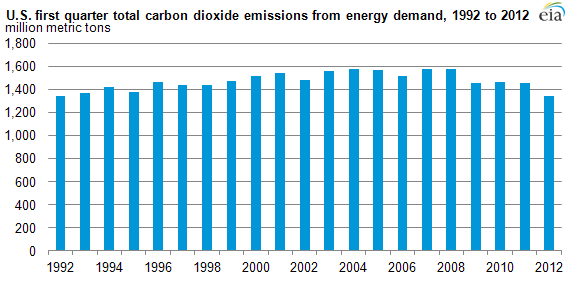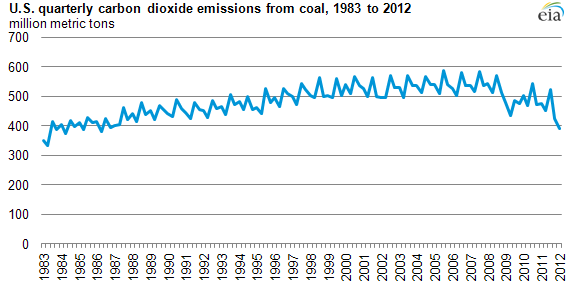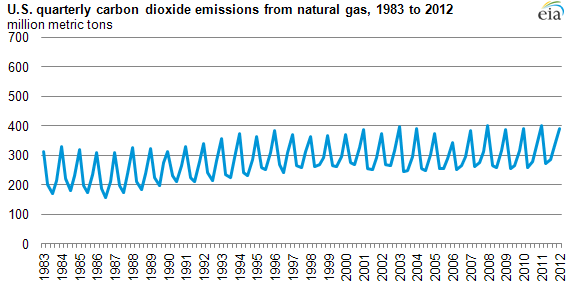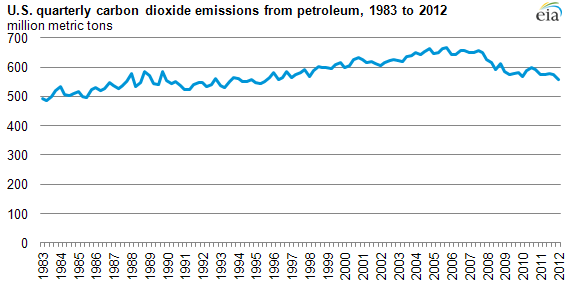
U.S. energy-related CO2 emissions in early 2012 lowest since 1992

Note: Reflects total carbon dioxide emissions in metric tons by quarter.
U.S. carbon dioxide (CO2) emissions resulting from energy use during the first quarter of 2012 were the lowest in two decades for any January-March period. Normally, CO2 emissions during the year are highest in the first quarter because of strong demand for heat produced by fossil fuels. However, CO2 emissions during January-March 2012 were low due to a combination of three factors:
- A mild winter that reduced household heating demand and therefore energy use
- A decline in coal-fired electricity generation, due largely to historically low natural gas prices
- Reduced gasoline demand
U.S. CO2 emissions from energy consumption totaled 1,340 million metric tons during the first quarter of 2012, down nearly 8% from a year earlier and the lowest for the January-March period since 1992, according to the U.S. Energy Information Administration's June Monthly Energy Review.

Note: Reflects total carbon dioxide emissions in metric tons by quarter.
CO2 emissions from coal were down 18% to 387 million metric tons in the January-March 2012 period. That was the lowest-first quarter CO2 emissions from coal since 1983 and the lowest for any quarter since April-June 1986. The decline in coal-related emissions is due mainly to utilities using less coal for electricity generation as they burned more low-priced natural gas.
About 90% of the energy-related CO2 emissions from coal came from the electric power sector. Coal has the highest carbon intensity among major fossil fuels, resulting in coal-fired plants having the highest output rate of CO2 per kilowatthour.

Note: Reflects total carbon dioxide emissions in metric tons by quarter.
CO2 emissions from natural gas were also down in the first quarter of 2012 compared to a year ago, natural gas-related CO2 emissions fell less (2.8%) than coal-related CO2 emissions, to about 391 million metric tons. While generators used more natural gas for electricity generation, overall CO2 emissions from natural gas were down because of lower gas heating demand this winter when temperatures were significantly above the historical average for the season.
The electric power sector accounted for about 27% of the CO2 emissions from natural gas, while 26% came from the residential sector. The industrial sector was the biggest producer of CO2 emissions from natural gas at 28% for the January-March 2012 period, but those emissions were up only 2 million metric tons from a year earlier.
Natural gas is the least carbon-intensive fossil fuel, producing the lowest CO2 emissions. Power plants that burn natural gas are also usually more efficient at converting fuel into electricity (i.e., they have a lower heat rate) than coal-fired power plants. The average operating heat rate for gas-fired power plants is about 21% lower than coal-fired electric generation facilities, creating less CO2 emissions.

Note: Reflects total carbon dioxide emissions in metric tons by quarter.
Petroleum CO2 emissions fell 2.7% during the first quarter of 2012 compared to the same period for 2011, to 559 million metric tons, due to reduced gasoline and heating oil consumption. Petroleum CO2 emissions were at the lowest level for any quarter since April-June 1996.